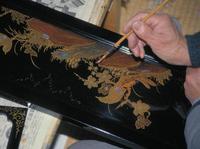

Total:131items
- Pottery & Porcelain (18)
- Lacquerware (4)
- Glasswork (2)
- Wood & Bamboo Work (19)
- Leather Work (1)
- Papermaking (13)
- Textile (20)
- Dyeing products (5)
- Masonry (1)
- Metal Work (11)
- Stationery (4)
- Livingware (3)
- Accessory (4)
- Toys & Entertainment (14)
- Interior (2)
- Other crafts (10)

 |
Main Production Site:Shiga |
 《Characteristics》
《Characteristics》Hama Butsudan, or Hama Buddhist Altar, is made in the way the parts can be dissembled and reassembled. For making Hama Butsudan, lacquering is done first, before assembling the altar. So, great accuracy in designing the parts and exact skills in lacquering are required. This precise accuracy is the reason why Hama Butsudan is acclaimed for being the most crafted Buddhist altar in Japan.
[Traditional Craft Officially Designated by Governor of Shiga Prefecture]
Contents provided by: Ishikyu Butsudan Ltd.
Translation by: Moe Shoji, reviewed by Hiroko Okamura

| Materials | Cypress, Japanese cedar |
|---|---|
| Crafting Processes | (1) Woodwork
Local cypress and Japanese cedar are carefully used for each part of the altar, after having dried. Particularly, Japanese Zelcova which has “tamamoku”, or the wood figure with circular burls, is selected and used. (2) Lacquering Base coat is applied several times with a technique called “kataji”. The parts are finished by “togidashi”, a technique which involves scraping and polishing. (3) Gold Leaf Stamping The gold leaves are applied on the parts, using lacquer. (4) Kazari Kanagu: Ornamental metal plates Copper plates are hand-carved and finished by coating with gold or gold amalgam. All ornamental metal plates are handcrafted. (5) Wood Carving The materials, Japanese Zelcova, cypress, cherry wood and sandal wood are carved in a pattern of the customers’ choice. (6) Makie: lacquer work The lacquer work is finished using glossy finish and mother-of-pearl in a pattern of the customers’ preference. The cost for “makie” work, or gold lacquer work, can vary, depending on the technique and the materials such as coral, mother-of-pearl, and gold lacquer. (7) Assembly A lot of crafted parts are assembled carefully. This process particularly requires concentration and attention to detail. Even a small part of paper screen doors can be dissembled. No mark of gold lacquer is not left even in the corners of the parts since each part is painted before assembling. |
| History | The Buddhism was brought to Japan in the mid-6th century, when the primitive Shintoism was still prevalent. Buddhism became common under the rule of Emperor Suiko (593 - 628). It was since this era that more Buddhist temples started to be built, such as Asuka-dera temple, and Horyu-ji temple and Shitenno-ji temple erected by Shotoku-taishi, and their temple building enshrining a Buddhist statue is considered as the model of a Buddhist altar. The existing Tamamushi-no-zushi in Horyu-ji is said to be the oldest Buddhist altar. Nevertheless, Buddhist altars were seen only in the household of officials and aristocrats those days, remaining beyond the means of general public.
Buddhism started to be commonly practiced among general public in Kamakura period (12c-14c). Buddhist altars became a part of life of common people, mainly because of the missionary work of Rennyo, the head priest of Jodo Shinshu, who recommended people to have altars in the household. As a practice, it was as simple as hanging a scroll of calligraphy of Buddhist chant, Namu Amida Butsu (南無阿弥陀仏) . It was in the Edo period (17c) when the Buddhist altars closer to what we have today became common among general public. This was because of the religious policy of the government, Danka (檀家) system. In this system, Shumon Ninbetu-cho (宗門人別帳), which functioned as a household register, was created in each local area and people were forced to be allocated to a local temple. The ban of Christianity is also considered to be one of the reasons why Buddhist altars became common: it is said that people were forced to have an altar as a proof of being a Buddhist, not a Christian. |
| Related URL | https://isikyu.net/ |
◆Exhibition / Showcase
Ishikyu Butsudan Ltd.
611 Shimonyu, Maibara-shi, Shiga
TEL: +81 (0)749-54-2567
FAX: +81 (0)749-54-0977



